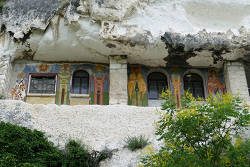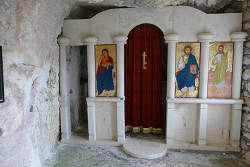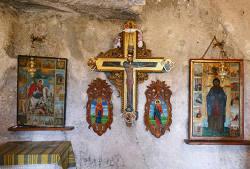Басарбовски манастир
Basarbovo Cave Monastery - Monastery of Saint Dimitar Basarbovski
Useful Information

| Location: |
Basarbovo, 10 km from Rousse city.
(43.766851, 25.964876) |
| Open: |
OCT to MAR daily 8-17. APR to SEP daily 8-19. [2020] |
| Fee: |
Adults BGN 3. Bulgarians and Romanians: free. [2020] |
| Classification: |
 Cave Church Cave Church
|
| Light: | n/a |
| Dimension: | |
| Guided tours: | self guided, D=1 h. |
| Photography: | allowed |
| Accessibility: | no |
| Bibliography: | |
| Address: | Monastery of Saint Dimitar Basarbovski, 7071 Basarbovo, Mobile: +359-889-155-293, Tel: +359-894-353-009. |
| As far as we know this information was accurate when it was published (see years in brackets), but may have changed since then. Please check rates and details directly with the companies in question if you need more recent info. |
|
History
| 1431 | first written mention in an Ottoman Tax Register. |
| 1685 | St. Dimitrii Basarbovski born in Basarbovo. |
| 1685 | St. Dimitrii Basarbovski died. |
| 13-JUL-1774 | General Petar Saltikov reaches Bucharest with the relics. |
| 1912 | archeological research by the researcher of Bulgarian antiquities Karel Shkorpil. |
| 14-MAY-1937 | monastery restored. |
| 1978 | named a historical landmark. |
| 24-SEP-2005 | foundation stone laid for new monastery church "St. Transfiguration of the Lord”. |
Description


The Басарбовски манастир (Basarbovo Monastery) is located near the town Basarbovo. The monastery was built into a limestone cliff face 35 m above river Rusenski Lom, south of the Danube. The caves were carved during the Second Bulgarian Empire (*1185-✝1396) by Hesychast monks, which came from the town of Hesychia and were known for their vow of silence. They lived simply and ascetically in constant prayer, deprivation, and silence in the hope to see Christ in His true light. The Basarbovo monastery was dedicated to St. Theodore Tyrone and St. Theodore Stratilat. Queen Theodora, the first wife of Tsar John Alexander and the daughter of the Wallachian voivode Ivanko Basarab became the founder of the monastery. Ivanko Basarab owned this land and the monastery was named after him, the name later became Basarbovo.
In the 16th century St. Sophronius of Bulgaria, also named St. Sophronius Basarbovski, lived here as a monk. According to legend after his burial miracles began to happen.
In the third year, his grave was opened and his body was found incorruptible and fragrant.
The Bulgarian-orthodox cave monastery is also named the Скален манастир „Св. Димитър Басарбовски“ (Cave Monastery of Saint Dimitar Basarbowski) after St. Dimitrii Basarbovski. He was born in Basarbovo in the 17th century, lived his whole life in the monastery in solitude and prayer, and finally died in the monastery in 1685. There is a legend connected with his death.
After his death, the saint appeared in the dream of a blind girl from the neighbouring village. He told her that his body was lying in the river. When his corpse was found, it was imperishable and fragrant. And the girl was able to see again.
Actually he was almost forgotten, but Saint Paisius of Hilendar told the story of his life in his monumental work Istoriya Slavyanobolgarskaya (Slavonic-Bulgarian History). During the Russian-Turkish War, the Russian General Petar Saltikov heard about St. Dimitrii Basarbovo and wished to worship the saint’s relics. In 1774 he requested permission to take them to Russia. He obtained the assent, but the relics ended up in Bucharest instead.
When General Petar Saltikov was transfering the remains of St. Dimitrii Basarbovo to Russsia he came to Bucharest. At that time the plague was in Romania and people were dying in large numbers. In the moment the relics entered Bucharest, the epidemic disappeared and people suddenly got better. Nobody died from the plague after this moment. The people asked the general to leave the saint in their city, a request he could not refuse. Since this time the remains are in Bucharest and can be seen in the Romanian Patriarchal Cathedral, the Metropolitan Church.
How long the monastery remained inhabited is unknown, but finally it was abandoned. It was brought back to life by the monk Hrisant in the 20th century and renovated. In the following decades only one monk lived at the monastery. But in 2005 the construction of the new church started and the monastery was enlarged. Today it is the only active cave monastery in Bulgaria.
On the level of the river is an entrance gate leading to a garden with a well dug by Saint Dimitrii himself, the water is said to have healing properties. From here a staircase with 48 stairs leads to the caves. It is possible to visit the cells and cave chapel. There is the alcove where Saint Dimitar used to sleep. The cave church is located in the cave where a wood-carved iconostasis and a whole-length icon of the saint were discovered. The caves are not inhabited anymore, the monks live in a new monastery building at the foot of the cliff but use the old church.
- See also
 Search DuckDuckGo for "Basarbovo Cave Monastery"
Search DuckDuckGo for "Basarbovo Cave Monastery" Google Earth Placemark
Google Earth Placemark Basarbovo Monastery - Wikipedia (visited: 04-AUG-2020)
Basarbovo Monastery - Wikipedia (visited: 04-AUG-2020) Скален манастир „Св. Димитър Басарбовски“, official website
Скален манастир „Св. Димитър Басарбовски“, official website  (visited: 04-AUG-2020)
(visited: 04-AUG-2020) Basarbovo Monastery of Saint Dimitar Basarbovski (visited: 04-AUG-2020)
Basarbovo Monastery of Saint Dimitar Basarbovski (visited: 04-AUG-2020) St. Dimitrii of Basarbovo Monastery – the only active rock monastery in Bulgaria (visited: 04-AUG-2020)
St. Dimitrii of Basarbovo Monastery – the only active rock monastery in Bulgaria (visited: 04-AUG-2020)
 Index
Index Topics
Topics Hierarchical
Hierarchical Countries
Countries Maps
Maps